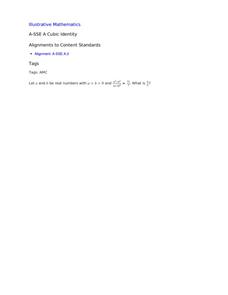Flipped Math
Factor Trinomials
Is it possible to factor out more? Scholars view a video presentation on factoring second degree trinomials. They learn about the magic X method to keep track of the constant factors. To finish, scholars use the learned method while...
Utah Education Network (UEN)
Expressions and Equations
Variables may be unknown, but expressions and equations are easy to understand. Pupils learn to write, evaluate, and simplify numeric and algebraic expressions. They also investigate how to write and solve simple equations and...
Willow Tree
Solving Quadratic Equations
Polynomials are full of solutions! Learners understand that the degree determines the number of solutions. Examples show quadratic equations solved by factoring and by using the quadratic formula. A cubic equation is even mixed in for...
Flipped Math
Factor Trinomials by Grouping
Help! The leading coefficient is not one. Learners view a video showing a technique to factor trinomials when the leading coefficient is not one. Pupils try a few examples including solving equations by factoring and check their answers...
Mathed Up!
Solving Quadratics by Factorising
Young mathematicians view a video on solving quadratic equations by factoring. They use this skill to complete a worksheet of practice problems — a great way to gauge understanding!
Flipped Math
Multi-Step Factoring
Bring all the factoring together. Pupils view a video presentation that shows how to combine all the factoring techniques from Unit 9 together to factor more complex polynomials. Learners practice with three items within the presentation...
El Paso Community College
Quadratic Equations
This resource has everything you need to know about solving quadratic equations. Factoring, completing the square, the quadratic formula, and using the discriminant are all there with with worked out examples and a 25 problem activity...
Utah Education Network (UEN)
Expressions and Equations Part 1
Express your love of equations! Pupils first learn to write and simplify numerical and algebraic expressions. Then, create and solve two-step equations. The progression is a great way to introduce the concept slowly.
CK-12 Foundation
Comparing Methods for Solving Quadratics: Comparing Methods to Solve a Quadratic
Determine the quickest process for solving quadratics. Pupils compare the number of steps in the process of solving quadratics using three different methods. Scholars determine which situations lend themselves to the different solving...
Flipped Math
Greatest Common Factor
Break it down to solve it. Learners watch a video on how to factor out the greatest common factor for algebraic expressions. They see how to use factoring and the zero product property to solve polynomial equation and practice their...
Flipped Math
Zeroes of Polynomials
Zero in to find the correct answer. Scholars find out how to solve a polynomial equation by factoring to find the zeroes. Learners use their knowledge of factoring polynomials and solving linear equations to find all of the solutions and...
Benjamin Franklin High School
Saxon Math: Algebra 2 (Section 3)
In this third of a twelve-part series, the focus moves from using matrices to solving systems of equations with substitution and elimination, including more than two dimensions and variables in equations, and analyzing statistical data....
Cabrillo College
Elementary Algebra
Hello Algebra! If you're in need of a resource with a books worth of examples and practice problems, this is it. Some topics include linear equations, polynomials and exponents, rational expressions, quadratic equations, and a great...
Virginia Department of Education
Factoring for Zeros
Relate factors to zeros and x-intercepts. Scholars first graph quadratics in both standard and factored forms to see that they are the same. They go on to use the graphs to see the relationship between factors and x-intercepts.
Rice University
Elementary Algebra
Find all the Algebra 1 content in one location. A helpful eBook contains the content typically found in an Algebra 1 course. Concepts range from solving and graphing linear equations to solving and graphing quadratic equations. Pupils...
Illustrative Mathematics
An Integer Identity
Challenge algebra learners to use the difference of cubes to solve this problem. Once your charges have taken out the factor (a - b), combined the like terms and set them equal to zero, the problem becomes a factorable quadratic...
Rice University
Intermediate Algebra
Algebra concepts are all wrapped up in one nice bow. The resource combines all the concepts typically found in Algebra I and Algebra II courses in one eBook. The topics covered begin with solving linear equations and move to linear...
Curated OER
Calculate the Slope of a Line Using Two Points
Find that slope! This video does an excellent job of demonstrating how to use the slope formula to find the slope of a line using two points. The instructor first reviews the definition of slope of a line, then works three problems using...
Alabama Learning Exchange
Classifying Complex Numbers
Imaginary numbers are a real thing. Scholars learn about complex numbers, real numbers, and imaginary numbers. They classify given numbers as strictly complex, strictly real, or strictly imaginary in an individual or group activity.




















